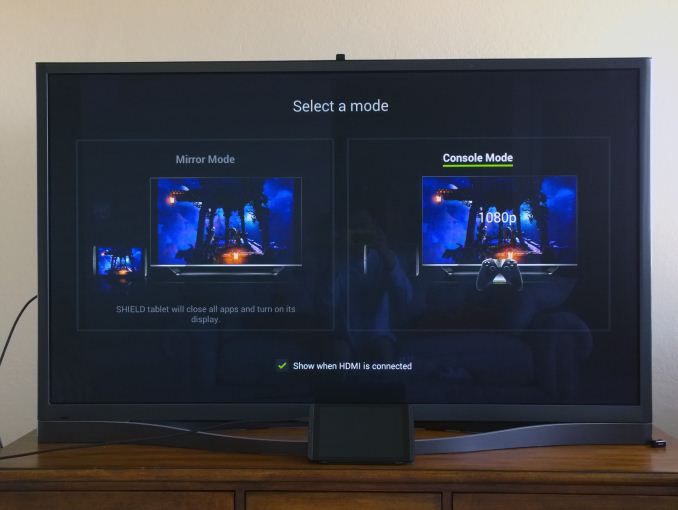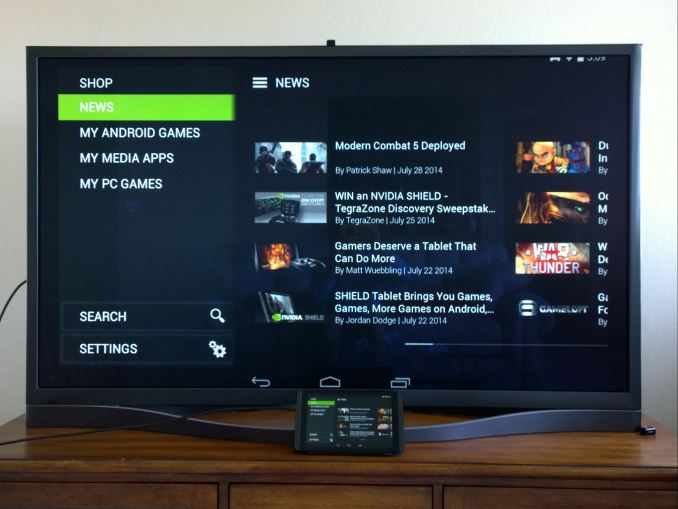The NVIDIA SHIELD Tablet Review
by Joshua Ho on July 29, 2014 9:00 AM ESTSoftware
In the UI department, there’s not too much to talk about. Much like Motorola, NVIDIA has stuck to using the AOSP UI design. Of course, there are plenty of NVIDIA-specific applications, but I didn’t run into any issues using the tablet to do everyday tasks. In this respect, things have improved massively over Shield portable. Because this tablet works in both portrait and landscape, there aren’t any issues with applications that force portrait mode like there were with the Shield portable. In normal tablet usage, it works as one might expect, with no real perceived lag throughout the UI. Of course, this is when compared to other Android devices. There are still frame drops involved in scrolling through lists and similar areas where Android has traditionally struggled to stay smooth, but Android L should fix this issue for the most part.
DirectStylus 2
The real value that the Shield tablet brings as a tablet is the stylus functionality. DirectStylus 2 is definitely much, much better than any other capacitive stylus on the market. The tip allows for precise control and it’s definitely responsive to changes in pressure. For the most part, there are only small issues here. Because the stylus is capacitive, it’s not really possible to have a floating pointer the way Wacom styluses do. In addition, I noticed that I need to lift the stylus a bit more than I might with pencil and paper in order to start a new letter or word or else my words would start to flow together. For the most part though, it works well enough, and the inking latency is low. Unfortunately the issue here is more of ecosystem than hardware, as most stylus-enabled applications aren’t nearly as robust as OneNote on Windows x86.
Console Mode
Of course, the real question here is whether the gaming side is worth the price premium. NVIDIA has gone all out on this area, and their efforts are split up into multiple aspects. The first is the TV interface/console mode, then the gameplay recording feature known as ShadowPlay. Finally, there’s the aspect of GameStream and GRID, which make it possible for games to be played on the tablet that otherwise wouldn’t work due to the compute requirements.
The TV interface effectively boils down to Shield Hub and Google Now, although it’s fully possible to use the full tablet UI as desired in this mode. In the hub, launching games and various applications like YouTube and Netflix is rather simple compared to the more cumbersome full Android UI as they have their own category in Shield Hub. In addition, launching applications through Google Now works as expected. Overall, there aren’t any friction points here. It works as well as one could expect. There is a strong reliance on voice input in general, but it’s much better than trying to type with a controller and better than most smart TV experiences. While the TV interface is mostly targeted towards enabling a console gaming experience, YouTube and Netflix both work great in this mode. NVIDIA has also gone through the necessary DRM certification process to allow for 1080p Netflix streaming. In essence, this device is already ready to serve as an Android TV device.
ShadowPlay
ShadowPlay, which we first saw in GeForce GTX GPUs, is also another major advantage that NVIDIA brings to the table for software experience. In short, this leverages the hardware H.264 video encoder that is on the Tegra K1’s Kepler GPU to provide video capture of gameplay or anything else displayed by the tablet. There are three possible options for video capture. The first is Twitch broadcasting, something that NVIDIA is quite proud of as they are the first to implement such a feature in an Android tablet. While I personally don’t stream on Twitch, a demo of Twitch broadcasting in the initial launch briefing worked without any visible quality issues in either audio or video.
There are two other recording modes. One is a standard start/stop recording feature, but the other is ShadowPlay/Auto Recording. In short, this keeps anywhere from the past minute to 20 minutes in video. This makes it possible to set and forget about the recording feature rather than constantly managing recordings in manual mode. All of these modes can use the tablet’s microphone and front facing camera for commentary purposes as needed. Local recordings seem to have a maximum of 1080p30, and Twitch broadcasts are limited to 720p30.
While those are the technical details, it’s a painless process. All the user has to do is long press the back button on the controller and select what kind of a recording they’d like to do (Twitch, Auto, Manual, Screenshot) and that’s it. I can see significant potential in this area especially if this device takes off as a gaming platform.
















174 Comments
View All Comments
ol1bit - Sunday, October 19, 2014 - link
I know this is old, but my tf201 with a tegra 3 still plays games great! Uninstalling facebook really helped overall speed!UpSpin - Wednesday, July 30, 2014 - link
The Tegra K1 is lacking an on-chip modem, thus it will always be less efficient than Qualcomm processors, which means we'll probably never see this SoC in a smartphone.I think we'll see much more Tegra producs with the K1, because it's really an impressive SoC. But NVidia seems to care less about the typical consumer tablets, more about their own console ecosystem (Shield) and most importantly embedded systems (cars), where NVidia has some huge partners and the Tegra gets widely used. (Tesla, Mercedes, VW, Audi, ...). There they can make more money most probably and don't have to give their IP away for free more or less to remain competive against companies like Mediatek.
fivefeet8 - Thursday, July 31, 2014 - link
The Snapdragon 805 is also in the same boat without an on-chip modem.Knowname - Wednesday, July 30, 2014 - link
who cares about the display? I get mine on Tuesday (preordered from Amaizon and picked no rush shipping fo da bling xD) and 90% of the time I'll be using it to play steam games on my TV.happycamperjack - Wednesday, September 3, 2014 - link
Just got it. The screen is actually pretty good! Much better than I expected. Great contrast, black level, colors. It's more than good enough for a tablet. I got the original Nexus 7. This is much much much better than that! It looks similar to me to the new Nexus 7.sherlockwing - Tuesday, July 29, 2014 - link
No Video playback battery life test?JoshHo - Tuesday, July 29, 2014 - link
It was definitely planned but there wasn't enough time to finish that test. I'll update the review once I have those results.ams23 - Tuesday, July 29, 2014 - link
Josh, how about some additional tests using the battery saver mode? Limiting fps to 30fps and reducing CPU clock operating frequencies should dramatically extend the gaming battery life with very graphically intensive benchmarks.On a side note, I should point out that not only does Tegra K1 have much higher Onscreen performance in GFXBench T-Rex HD test (which is the test used for battery lifetime and a minimum value long term performance data point) compared to most other ultra mobile GPU's, but is also renders with significantly higher [FP32] precision too. According to Oleg at B3D forum, Kishonti uses low precision FP16 shaders in the T-Rex test by default. Mobile Kepler and other modern day PC and console GPU architectures are designed for FP32 precision and not mixed or lower precision.
mkozakewich - Tuesday, July 29, 2014 - link
This! It's horrible to complain about the extra dynamic range like it's a bad thing, and then NOT test the battery-saving features.Limit the CPU such that it runs like the Shield portable, then set the framerate to 30 Hz and run the gaming battery tests again.
(On my Surface Pro, for example, I'll set everything to the lowest possible, about 800 MHz, and I'll get a couple more hours out of it while playing games. High-Performance mode is for when you're plugged in.)
JoshHo - Tuesday, July 29, 2014 - link
Those are definitely planned as well, there were some issues with meeting deadlines so battery life testing had to be cut down somewhat.